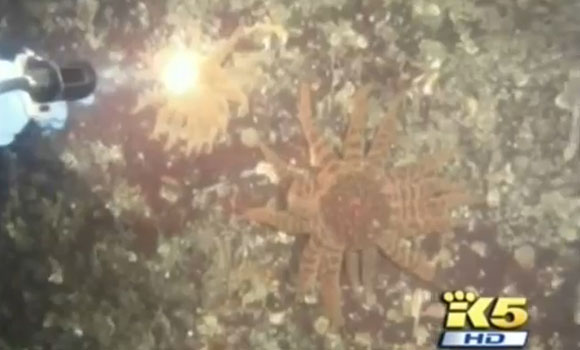
‘Melting’ Starfish Along West Coast Prompts Fukushima Fears
Mikael Thalen
Scientists are attempting to find out why one species of starfish is literally melting in the waters off of Washington state and Canada.
Biologists in Seattle took to the Puget Sound waters last weekend to collect sick and healthy sunflower starfish for testing. Several labs including one at Cornell University will examine and compare samples with Canadian specimens already being analyzed.
“We’ve got some sea stars that look like they’re melting on the bottom,” Seattle Aquarium biologists Jeff Christiansen said.
Whether the cause is environmental or disease related is currently unknown, but the number of melting starfish increases drastically with each passing day.
“At this time, we don’t have a good idea of what’s causing it, so we’re going to look for everything,” Christiansen said. “There are a lot of melting sea stars out there, more than even a couple days ago.”
According to Veterinarian Lesanna Lahner, the starfish specie’s condition is rapidly deteriorating, with more than half displaying the same disturbing symptoms.
“It’s concerning to hear in a short time period we’re seeing 60% of this species diseased in this area,” Lahner said.
Strangely, the symptoms have only been seen in certain areas of Washington’s Puget Sound and Canadian waters. While the verdict is still unknown, many are pointing fingers to Japan’s Fukushima nuclear power plant, which has continued to leak over 300 tons of highly radioactive water into the ocean every day.
As reported by investigative journalist Michael Snyder, massive evidence of Fukushima’s effect on the West Coast continues to be evident despite the silence from most western media.
Earlier this month, Canadian authorities found massively high radiation levels in sea bass, with one fish showing 1,000 becquerels per kilogram of cesium.
Plankton tested from Hawaii to the West Coast have been found to have high levels of cesium-137, with scientists in California finding the same isotopes present in 15 out of 15 Bluefin Tuna tested.
Even in light of one Canadian study that found cesium-137 present in 100 percent of carp, seaweed, shark and monkfish sold to the Canadian public, western governments have continued to import Japanese sea food.
As radiation levels rise, it is likely the EPA will continue to raise ‘acceptable levels’ of radiation in the food supply. With experts predicting a grim outlook, the best options now available are informing others while protecting one’s thyroid health from increased radiation exposure.
Read more: http://www.storyleak.com/melting-starfish-along-west-coast-prompts-fukushima-fears/#ixzz2jIpUY33G

